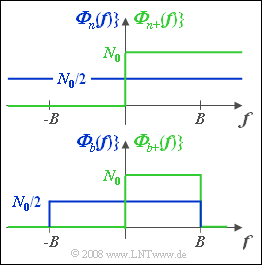Exercise 4.12Z: White Gaussian Noise
A noise signal $n(t)$ is called white; if it contains all spectral components without preference of any frequencies.
- The physical Power spectral density defined only for positive frequencies $f$ ${\it \Phi}_{n+}(f)$ is constant $($equal $N_0)$ and extends frequency-wise to infinity.
- ${\it \Phi}_{n+}(f)$ is shown in green in the upper graph. The plus sign in the index is to indicate that the function is valid only for positive values of $f$ .
- For mathematical description one usually uses the two-sided Power spectral density spectrum ${\it \Phi}_{n}(f)$. Here applies for;all frequencies from $-\infty$ to $+\infty$ (blue curve in the upper picture):
- $${\it \Phi}_n (f) ={N_0}/{2}.$$
The bottom graph shows the two Power spectral densities ${\it \Phi}_{b}(f)$ and ${\it \Phi}_{b+}(f)$ of a bandlimited white noise signal $b(t)$ It holds with the one-sided bandwidth $B$:
- $${\it \Phi}_b(f)=\left\{ {N_0/2\atop 0}{\hspace{0.5cm} {\rm f\ddot{u}r}\quad |f|\le B \atop {\rm else}}\right.,$$
- $${\it \Phi}_{b+}(f)=\left\{ {N_0\atop 0}{\hspace{0.5cm} {\rm f\ddot{u}r}\quad 0 \le f\le B \atop {\rm else}}\right.$$
For computer simulation of noise processes, band-limited noise must always be assumed, since only discrete-time processes can be handled. For this, the SamplingTheorem must be obeyed. This states that the bandwidth $B$ must be set according to the pitch $T_{\rm A}$ of the simulation.
Assume the following numerical values throughout the exercise:
- The noise power density – with respect to the resistor $1 \hspace{0.05cm}\rm \Omega$ – beträgt $N_0 = 4 \cdot 10^{-14}\hspace{0.05cm}\rm V^2/Hz$.
- The (one-sided) bandwidth of the band-limited white noise is $B = 100 \hspace{0.08cm}\rm MHz$.
Hints:
- This exercise belongs to the chapter Power-Spectral Density.
- Reference is also made to the chapter Auto-correlation function.
- The properties of white noise are summarized in the second part of the tutorial video The AWGN channel (German) .
Questions
Solution
- The auto-correlation function (ACF) is the Fourier transform of the Power spectral density (PSD). Here:
- $${\it \Phi}_n (f) = {N_0}/{2} \hspace{0.3cm} \bullet\!\!-\!\!\!-\!\!\!-\!\!\circ\, \hspace{0.3cm} \varphi_n (\tau)={N_0}/{2} \cdot {\rm \delta} ( \tau).$$
- However, there is no "real" white noise in physics, since such a noise would have to have an infinitely large signal power $($the integral over the PSD as well as the ACF value at $\tau = 0$ are both infinitely large$)$.
- Thermal noise has a constant PSD up to frequencies of about $\text{6000 GHz}$ . Since all (current) üb transmission systems operate in a much lower frequency range, thermal noise can be said to be "white" to a good approximation.
- The statistical property "white" says nothing about the amplitude distribution, which is determined by the probability density function (PDF) alone.
- When considering the phase of a bandpass signal as the stochastic variable, it is often modeled as uniformly distributed between $0$ and $2\pi$ .
- If there are no statistical bindings between the respective phase angles at different times, this random process is also "white".
(2) The Power spectral density spectrum is a rectangle of width $2B$ and height $N_0/2$.
- The inverse Fourier transformation yields an si function:
- $$\varphi_b(\tau) = N_0 \cdot B \cdot {\rm si} (2 \pi B \tau)\hspace{0.3cm} \Rightarrow \hspace{0.3cm}\varphi_b(\tau = 0) = N_0 \cdot B \hspace{0.15cm}\underline {=4}\cdot 10^{-6} \ \rm V^2.$$
(3) The ACF value at the point $\tau = 0$ gives the power.
- The root of this is called the rms value:
- $$\sigma_b = \sqrt{\varphi_b(\tau = 0)} \hspace{0.15cm}\underline {=2 \hspace{0.05cm}\rm V}.$$
(4) The ACF computed in (3) has zeros at equidistant distance from $T_{\rm A}= 1/(2B)\hspace{0.15cm}\underline {=5\hspace{0.05cm} \rm ns}$:
- There are no statistical bindings between the two signal values $b(t)$ and $b(t + \nu \cdot T_{\rm A})$,
- where $\nu$ can take all integer values.
(5) The correct solution is suggested solution 2.
- The ACF value at $\tau = T_{\rm A} = 1 \hspace{0.05cm}\rm ns$ amounts to.
- $$\varphi_b(\tau = T_{\rm A}) = {\rm 4 \cdot 10^{-6} \hspace{0.1cm}V^2 \cdot si (\pi/5) \approx 3.742 \cdot 10^{-6} \hspace{0.1cm}V^2} > 0.$$
- This result says: Two signal values separated by $T_{\rm A} = 1 \hspace{0.05cm}\rm ns$ are positively correlated:
- If $b(t)$ is positive and large;, then with high probability $b(t+1 \hspace{0.05cm}\rm ns)$ is also positive and large;.
- In contrast, there is a negative correlation between $b(t)$ and $b(t+7 \hspace{0.05cm}\rm ns)$ If $b(t)$ is positive, then $b(t+7 \hspace{0.05cm}\rm ns)$ is probably negative.

